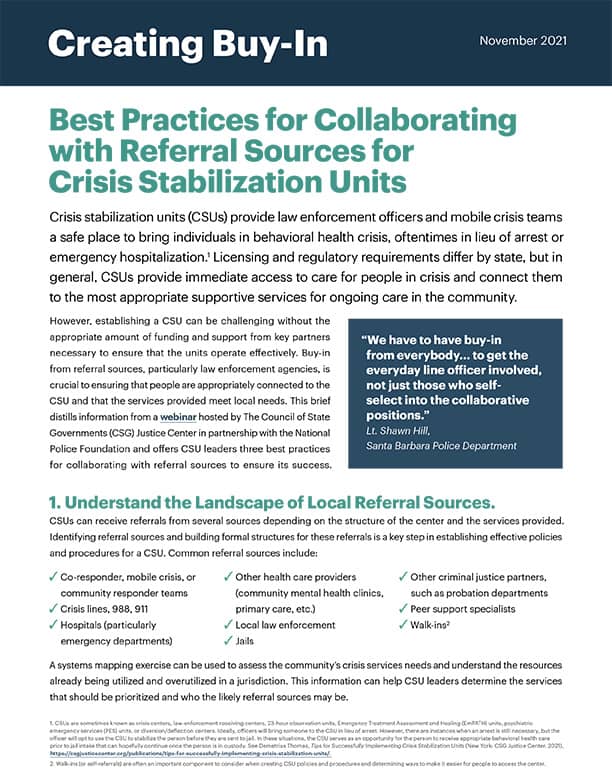Creating Buy-In: Best Practices for Collaborating with Referral Sources for Crisis Stabilization Units
Crisis stabilization units offer law enforcement officers and mobile crisis teams a safe place to bring people in behavioral health crisis, often in lieu of arrest or emergency hospitalization. However, they can be challenging to establish without the appropriate funding and support from key partners needed to operate the units effectively. Creating buy-in among referral sources, is one important component of achieving this support needed. This brief offers crisis stabilization unit leaders three best practices for collaborating with referral sources to ensure its success. Photo by camilo jimenez on Unsplash
Creating Buy-In: Best Practices for Collaborating with Referral Sources for Crisis Stabilization Units
Crisis stabilization units (CSUs) provide law enforcement officers and mobile crisis teams a safe place to bring individuals in behavioral health crisis, oftentimes in lieu of arrest or emergency hospitalization.1
Licensing and regulatory requirements differ by state, but in general, CSUs provide immediate access to care for people in crisis and connect them to the most appropriate supportive services for ongoing care in the community. However, establishing a CSU can be challenging without the appropriate amount of funding and support from key partners necessary to ensure that the units operate effectively. Buy-in from referral sources, particularly law enforcement agencies, is crucial to ensuring that people are appropriately connected to the CSU and that the services provided meet local needs. This brief distills information from a webinar hosted by The Council of State Governments (CSG) Justice Center in partnership with the National Police Foundation and offers CSU leaders three best practices for collaborating with referral sources to ensure its success.
1. Understand the Landscape of Local Referral Sources.
CSUs can receive referrals from several sources depending on the structure of the center and the services provided. Identifying referral sources and building formal structures for these referrals is a key step in establishing effective policies and procedures for a CSU. Common referral sources include:
- Co-responder, mobile crisis, or community responder teams
- Crisis lines, 988, 911
- Hospitals (particularly emergency departments)
- Other health care providers (community mental health clinics, primary care, etc.)
- Local law enforcement
- Jails
- Other criminal justice partners, such as probation departments
- Peer support specialists
- Walk-ins2
A systems mapping exercise can be used to assess the community’s crisis services needs and understand the resources already being utilized and overutilized in a jurisdiction. This information can help CSU leaders determine the services that should be prioritized and who the likely referral sources may be.
2. Foster Effective Partnerships with Referral Sources.
Once CSU leaders determine who their likely referral sources will be, they will need to establish formal partnerships to encourage continued support for the CSU. One important way to do this is outlining clear communication pathways, procedures, and responsibilities, usually with a memorandum of understanding3 that details each agency’s role with the CSU. Leaders may also want to consider a data sharing agreement or data sharing system to formalize information sharing among referral sources and partners; these will both need to be developed in accordance with federal and state privacy regulations. Additionally, involving referral sources in planning conversations regarding key decisions such as center location, services provided, and target population can help create a groundswell of support for the CSU and realistic expectations among system partners. Regularly scheduled weekly or monthly meetings with partners can then offer opportunities to receive ongoing feedback from referral sources on daily operations and where improvements are needed.
Many CSUs will leverage existing steering committees or create an advisory board to ensure that local leaders are able to provide oversight and have a forum for collaboration. Including key referral sources in these committees or advisory boards can engender support for the CSU and encourage ongoing engagement and participation in the activities and management of the CSU.4
3. Be Flexible to Meet Referral Sources’ Needs.
Ensuring that the CSU is responsive to local needs and easy to access is critical in garnering support from referral sources. During the webinar, representatives from some of the most common referral sources spoke about ways to ensure the CSU meets their needs and is convenient and easy to access. Below are some examples that they offered:
- Accept both walk-ins and referrals.
- Allow for referrals of people who may remain in police custody.
- Accept all law enforcement referrals, including people who are acutely agitated or intoxicated.
- Ensure the CSU is in a convenient location with a quick drop-off process for law enforcement.
- Offer multiple types and levels of services, including services for mental health and substance use disorders.
- Provide diversion options for both hospitals and law enforcement.
To ensure referral resources needs are being met, CSU leaders should seek to not only include referral sources in the initial planning process, but also make sure that they are involved in all ongoing developments, particularly evaluations. Giving referral sources regular opportunities to evaluate the effectiveness of the CSU will help leaders better understand the needs of each referral source and respond to those needs in a timely fashion.
Additional Resources
Building a Comprehensive and Coordinated Crisis System
A Matter of Public Health and Safety: How States Can Support Local Crisis Systems
Advancing the Work of Peer Support Specialists in Behavioral Health-Criminal Justice Programming
Footnotes
1. CSUs are sometimes known as crisis centers, law-enforcement receiving centers, 23-hour observation units, Emergency Treatment Assessment and Healing (EmPATH) units, psychiatric emergency services (PES) units, or diversion/deflection centers. Ideally, officers will bring someone to the CSU in lieu of arrest. However, there are instances when an arrest is still necessary, but the officer will opt to use the CSU to stabilize the person before they are sent to jail. In these situations, the CSU serves as an opportunity for the person to receive appropriate behavioral health care prior to jail intake that can hopefully continue once the person is in custody. See Demetrius Thomas, Tips for Successfully Implementing Crisis Stabilization Units (New York: CSG Justice Center, 2021), https://csgjusticecenter.org/publications/tips-for-successfully-implementing-crisis-stabilization-units/.
2. Walk-ins (or self-referrals) are often an important component to consider when creating CSU policies and procedures and determining ways to make it easier for people to access the center.
3. For examples of memoranda of understanding, see the “Stepping Up Strategy Lab: Partnership Agreements,” CSG Justice Center, accessed September 20, 2021, https://lab.stepuptogether.org/database/entry/partnership-agreements/; “Sharing Behavioral Health Information within in Police-Mental Health Collaborations: Establishing an Information Sharing Approach,” CSG Justice Center, accessed September 20, 2021, https://csgjusticecenter.org/projects/police-mental-health-collaboration-pmhc/sharing-behavioral-health-information/forming-strong-collaborations/.
4. CSU leaders should also involve groups such as the National Alliance on Mental Illness, local advocacy groups, recovery courts, community members, and community behavioral health or other service providers to ensure to build consensus in the community and ensure all points of view are considered.
Project credits
Writing: Marilyn Leake, CSG Justice Center
Research: Marilyn Leake, CSG Justice Center
Advising: Dr. Allison Upton and Demetrius Thomas, CSG Justice Center, and National Police Foundation
Editing: Darby Baham, CSG Justice Center
Design: Michael Bierman
Public Affairs: Ruvi Lopez, CSG Justice Center
Web Development: Eleventy Group
Partner: National Police Foundation
This project was supported by Grant No.2019-MO-BX-K001 awarded by the Bureau of Justice Assistance. The Bureau of Justice Assistance is a component of the Department of Justice’s Office of Justice Programs, which also includes the Bureau of Justice Statistics, the National Institute of Justice, the Office of Juvenile Justice and Delinquency Prevention, the Office for Victims of Crime, and the SMART Office. Points of view or opinions in this document are those of the author and do not necessarily represent the official position or policies of the U.S. Department of Justice.
About the Author

The sharp rise in school shootings over the past 25 years has led school officials across the U.S.…
Read MoreA three-digit crisis line, 988, launched two years ago to supplement—not necessarily replace—911. Calling 988 simplifies access to…
Read MoreIt would hardly be controversial to expect an ambulance to arrive if someone called 911 for a physical…
Read More Taking the HEAT Out of Campus Crises: A Proactive Approach to College Safety
Taking the HEAT Out of Campus Crises: A Proactive Approach to College Safety
The sharp rise in school shootings over the past 25 years has…
Read More From 911 to 988: Salt Lake City’s Innovative Dispatch Diversion Program Gives More Crisis Options
From 911 to 988: Salt Lake City’s Innovative Dispatch Diversion Program Gives More Crisis Options
A three-digit crisis line, 988, launched two years ago to supplement—not necessarily…
Read More Matching Care to Need: 5 Facts on How to Improve Behavioral Health Crisis Response
Matching Care to Need: 5 Facts on How to Improve Behavioral Health Crisis Response
It would hardly be controversial to expect an ambulance to arrive if…
Read More










